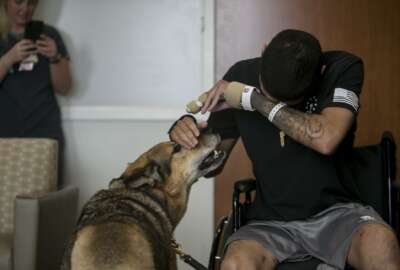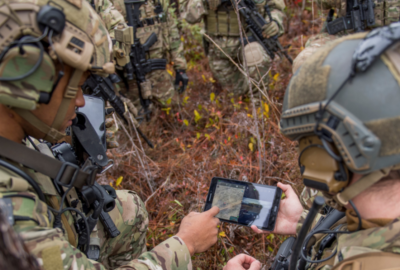Hubbard Radio Washington DC, LLC. All rights reserved. This website is not intended for users located within the European Economic Area.
On Air: Federal News Network
Trending:
Even after troops leave Afghanistan, Iraq, resulting brain injury research continuing for VHA
The chief of neuropathology at the VA Boston Healthcare System, Dr. Ann McKee returned to Federal Drive with Tom Temin for an update.
Best listening experience is on Chrome, Firefox or Safari. Subscribe to Federal Drive’s daily audio interviews on Apple Podcasts or PodcastOne.
As the United States draws troops from Afghanistan and Iraq, a source of injury and death will cease. But research by the Veterans Health Administration will continue. Two years ago we checked in with one of VA’s top researchers into brain injury and neuropathology. The chief of neuropathology at the VA Boston Healthcare System, Dr. Ann McKee returned to Federal Drive with Tom Temin for an update.
Interview transcript:
Tom Temin: And good to have you back.
Dr. Ann McKee: Well, thank you. It’s a pleasure to be here.
Tom Temin: And I think of you as the brain slice library lady, which is kind of an odd way to put it, but, you are known for the samples and the pathological pieces of brain that you keep and learn from. What has been some of the latest findings?
Dr. Ann McKee: Well, the war in Afghanistan might be ending, but the veterans and the other individuals who are exposed to these repetitive concussive events, the repetitive blast exposures, that problem doesn’t go away. There were over 300,000 that were exposed, and they continue to live with some difficulties. And, our research, I am the brain donor lady, I run a big brain bank on trauma — over 1,100 brains who are in that bank. And we’ve only been doing that for the last 13 years. But we also run the ALS and PTSD brain bank. So yes, I do see a lot of brains. And what we’ve learned from those is that there’s injuries after those exposures, and they’re not all the same. Veterans are different. And I don’t need to tell you that, but a lot of them play sports — football, hockey — and that makes them at risk for chronic traumatic encephalopathy, which we clearly see in some of the veterans who’ve been exposed to blast or concussive injury. And rarely we see CTE in people that have not been both, athletes and military service people. So, it’s much less common if they weren’t an athlete of some sort. But we do see CTE, the disease that we’ve described. So, I think clearly, in football players, we do see that in military veterans too. But almost all of them have some sports history, it doesn’t have to be a lot, but most of them have a dual exposure. We’re continuing to try to understand those symptoms that become so disabling and the vets — the sleep disorder, the depression, the anxiety, the changes in their behavior, and personality. Those are such difficult issues — difficult for them difficult for their loved ones — those are multifactorial, and they’re hard to pinpoint. We still don’t have a good way to diagnose them during life, how to pick up the real issue at hand for each person. But we’re getting closer. We get closer every day. So the work continues.
Tom Temin: And is it possible to know whether if someone has a brain injury of this severity, once that occurs, now we know that there is a cumulative effect if you keep getting hit, for example, or keep getting a blast — shockwave, but once those events are over, does the brain stay in a given state, or does it continue to possibly deteriorate?
Dr. Ann McKee: That’s the thing. Sometimes it stabilizes, which is awesome, or, and even improves. So the person is learning adaptive neural mechanisms — different brain pathways to overcome the injury — or they’re repairing the injury because the brain is capable of a certain degree of repair. But unfortunately, some individuals continue to progress. And those are the individuals that we really need to keep a close eye on. Because they become so despondent. They feel like no one can validate what they’re experiencing. They’re experiencing things that are difficult to diagnose — we don’t have a great way to detect brain injury except with a multitude of research techniques. And then they are at risk, because these guys develop suicidal thoughts, this disabling depression, terrific anxiety, sleep disorder, substance use, because they’re trying to cope as best they can. Those are the guys we really need to keep in our care system, evaluate, and as best as the medical system can, hug them and keep them feeling as well as possible.
Tom Temin: We’re speaking with Dr. Ann McKee, chief of neuropathology at the VA Boston Healthcare System. And speaking of giving people the high touch type of treatment and the hug and so on, I imagine the last year and a half of separation among people has really been tough on that particular population.
Dr. Ann McKee: Oh, absolutely. Feelings of isolation, feelings of ‘I’m the only one in the universe that’s going through this,’ ‘there’s something deeply wrong with me.’ It just exacerbates all of these issues. So the person thinks they’re somehow responsible for these issues. And that can’t be further from the truth. That they are all valiant warriors. Dealing with a brain injury, it takes a tremendous amount of perseverance, tremendous resilience, and just sort of, you’re coping, to really try to get through these dark days. And it’s not easy. And we don’t have great answers. But we keep pushing the envelope. I think we’re a lot further along than we were six years ago. Six years ago, we knew nothing. Now we have a better idea, but we still don’t have great treatments. In the next six years, I’m hoping that we have treatment.
Tom Temin: And do you have a system for reviewing, say, a sample that you might have put in the library, as you mentioned, 13 years ago, or 10 years ago? And do you ever go back to them and take a fresh look, based on some new learnings that might have come in from a new case?
Dr. Ann McKee: Absolutely. We don’t throw anything away, we keep everything in what we consider the optimal condition. Every brain is very, very precious to us. We, of course, maintain a very high level of privacy and no one’s private information is released. But, we use those brains continually. We never stop, we keep going back. The science advances by highly qualified individuals all over the world, certainly all over the country, studying these disorders from all their different points of expertise. And yes, we go back constantly, and every brain I just want to emphasize is treated with such the utmost care and consideration.
Tom Temin: And what is the process to convince someone that is perhaps in distress, and also perhaps at the end of their life? It’s a difficult ask, I imagine to donate that organ when they’re gone, because it does raise the question that, yes, you’re going to die eventually, and perhaps not unhappy circumstances. How do you go about that? How do you convince people in a humane way that this is really something that’s helpful to those that come after?
Dr. Ann McKee: Well, if someone has a suspicion, if they have a chronic condition, they realize the end is near, the ask is different. But in every case, this is a way to give back to advance the science, advanced knowledge so that your fellow service people can hopefully reduce their suffering in the future. This is a way to help your colleagues, your peers, the people that were with you on all these tours and are suffering some of the same symptoms. We may not have been quick enough to help you, but this is a way that you can help them. I think that resonates with a great deal of military service people. There’s a great esprit de corps, there’s comradeship, that feeling of helping those who come after is really part of the psyche, I think of most veterans.
Tom Temin: And you get the sense that the military has become more receptive to the idea of preventing brain injury in training and in exercises outside of combat?
Dr. Ann McKee: I think they have but we have a long way to go, because their goal is to produce the most valiant warrior, but at the same time, they need to protect the most precious organ in your body, which is your brain. Your brain actually is responsible for your identity — who you think of as yourself. It’s your way of thinking, your memory, your emotions, your personality. It is such a precious thing. And I think it’s slowly where organizations like the military, like major sports leagues are adopting safer policies. But it’s a long, long haul, because in the short run, it’s difficult for them.
Tom Temin: Well I think some of the sports leagues look at the dollar signs before they look at the human side. And that’s a pretty hard culture to crack.
Dr. Ann McKee: I’d say you’re absolutely right. And unfortunate because the athlete and the military personnel, they’re our most precious commodity. Those sports wouldn’t be so popular if the athletes themselves weren’t so gifted. And certainly our military can’t run without incredible people. So I just want to keep the people, the importance of that human being alive for these major entities.
Tom Temin: Dr. Ann McKee is chief of neuropathology at the VA Boston Healthcare System. As always, thanks so much for joining me.
Dr. Ann McKee: Well thank you. It’s been a pleasure.
Copyright © 2024 Federal News Network. All rights reserved. This website is not intended for users located within the European Economic Area.
Tom Temin
Tom Temin is host of the Federal Drive and has been providing insight on federal technology and management issues for more than 30 years.
Follow @tteminWFED





